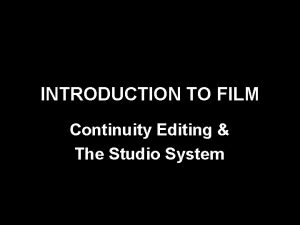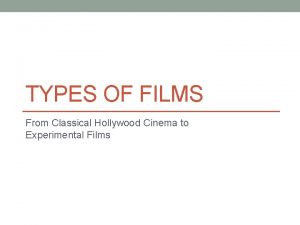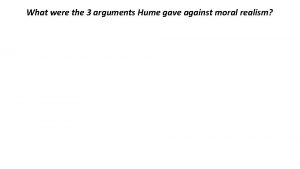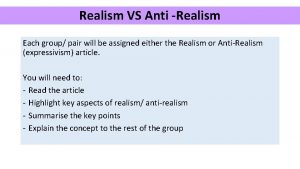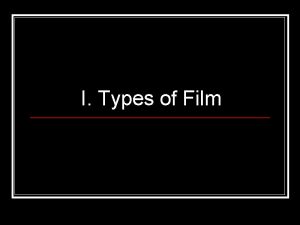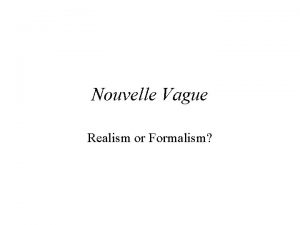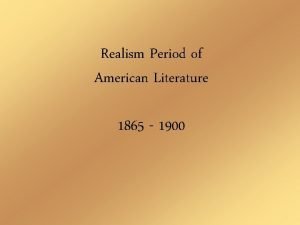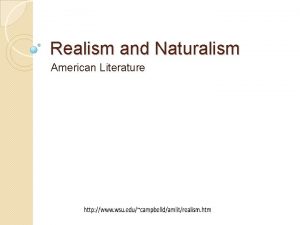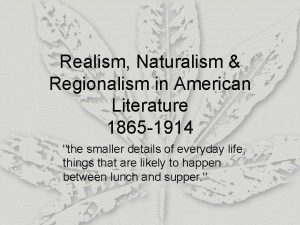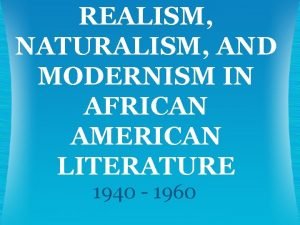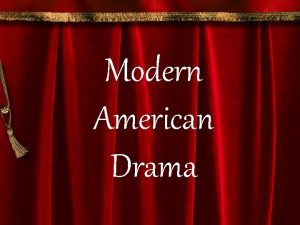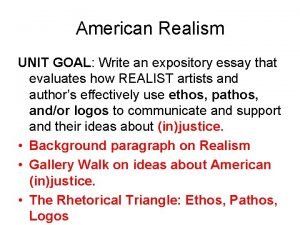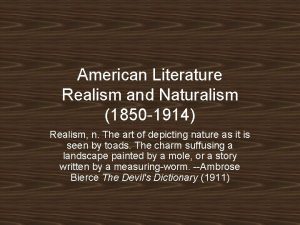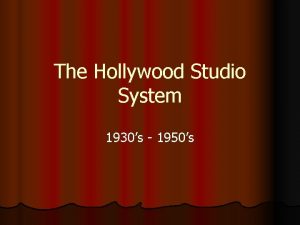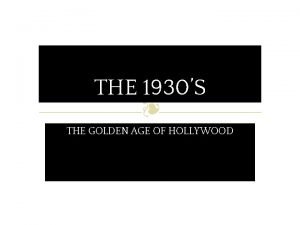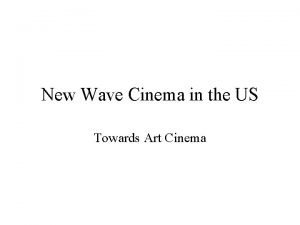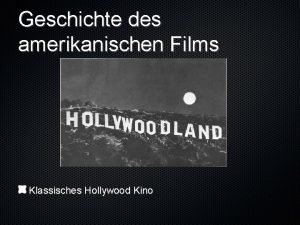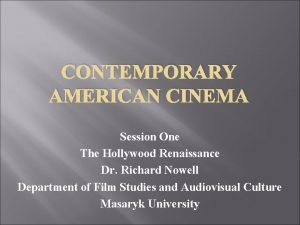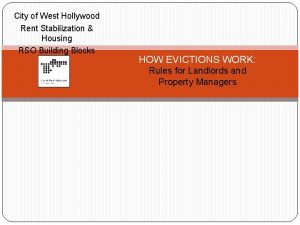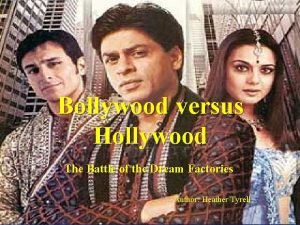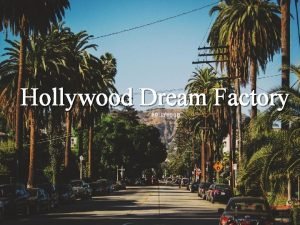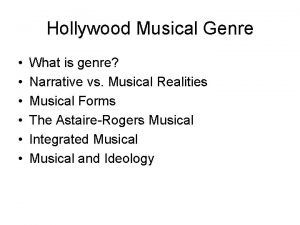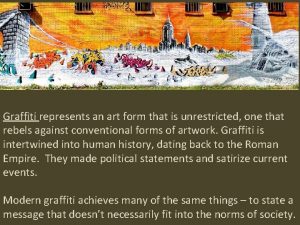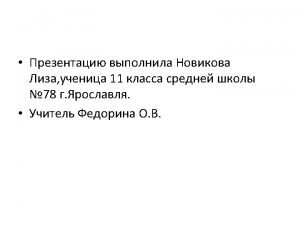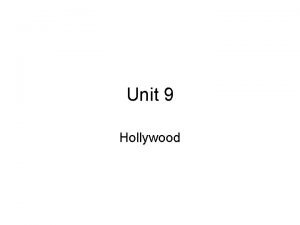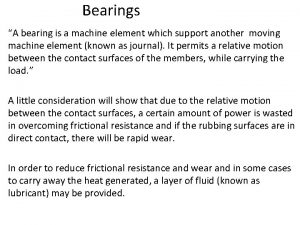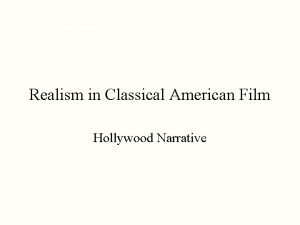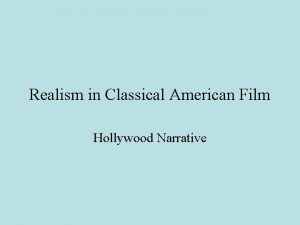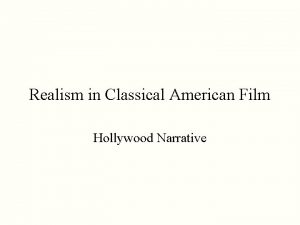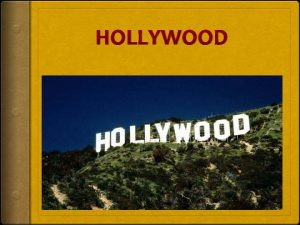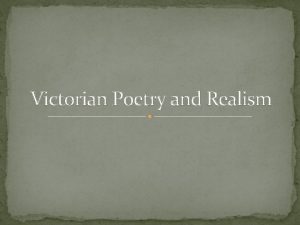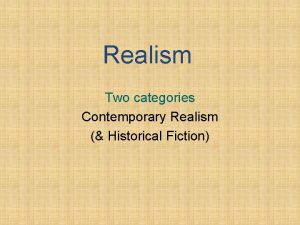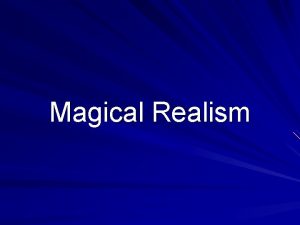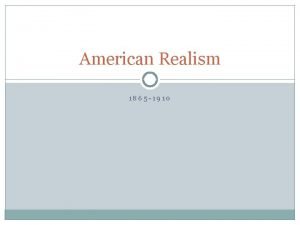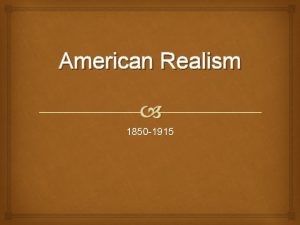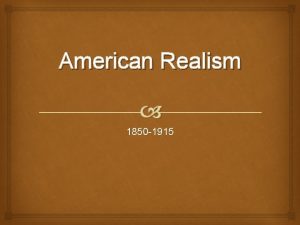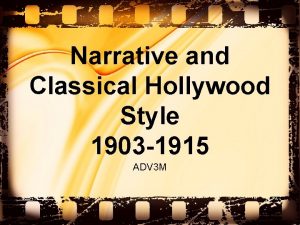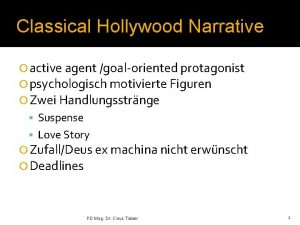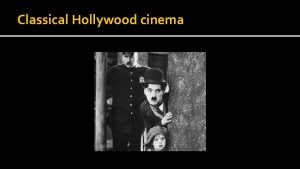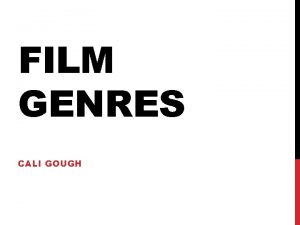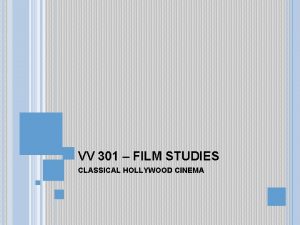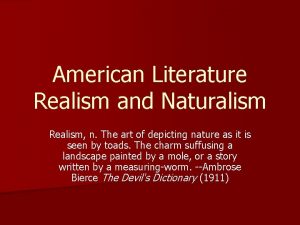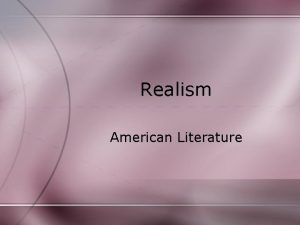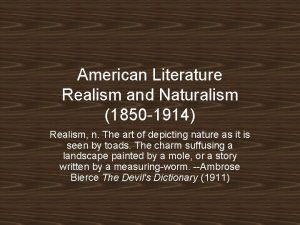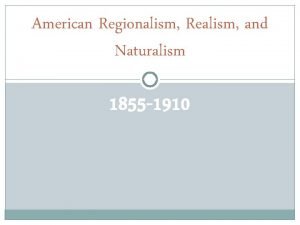Realism in Classical American Film Hollywood Narrative Film








































- Slides: 40

Realism in Classical American Film Hollywood Narrative

Film as Illusion ‘The old experience of the movie-goer, who sees the world outside as an extension of the film he has just left (because the latter is intent upon reproducing the world of everyday perceptions), is now the producer’s guideline. The more intensely and flawlessly his techniques duplicate empirical objects, the easier it is today for the illusion to prevail that the outside world is the straightforward continuation of that presented on the screen. This purpose has been furthered by mechanical reproduction since the lighting was taken over by the sound film. ’ Theodor V. Adorno and Max Horkheimer, Dialectic of Enlightenment, p. 126

Film as Illusion FILM IS ILLUSION OF WHAT? • Illusion that what you are watching is a ‘real’ world. ‘… spectators experience the diagetic world as environment. ’ Noël Burch (diegetic = in a story) • Film as combination of ‘imaginary signifiers’ Christian Metz (imaginary = the state in which you cannot distinguish between the real and the invented > Lacanian psychoanalysis (signifier = sign)

Film as Illusion • Woody Allen’s Purple Rose of Cairo (1985) • Extreme exposition that film could work as illusion

Film as Illusion CLASSICAL AMERICAN FILM AS ILLUSIONIST FILM • American cinema developed its techniques and styles in order to dupe the spectator to take a narrative and images for reality; • Or to increase its reality and truth effects. • The spectator is willing to accept illusion or demand it in film.

American Classics as Realist Films • (Classical) Hollywood products between 1917 and 1960 are considered as a type of realist films. • Why 1917 and 1960? • By 1917 most American fiction adopted fundamentally similar narrative strategies; PROSIBILITY

American Classics as Realist Film The studio mode of production had been organized around the division of labour, hierarchical managerial system, factory-like system of filmmaking CONTINUATION of the established uniformity in narrative and visual styles

Classical American Film as Realist Film • The 1960 s - the end of Hollywood’s traditions • Studios moved to the production of television programmes → The breakdown of studio system (stars turning free agents; producers becoming independent; the death of B-movies and decrease in demand for studio directors and staff)

American Classics as Realist Films • Challenge from international art cinema, e. g. Ingmar Bergman, Akira Kurosawa, Italian neorealists and French directors of Nouvelle Vague DIVERSIFICATION in contents and styles

American Classics as Realist Films TECHNIQUES, STYLES AND STRATEGIES EMPLOYED TO CREATE AN ILLUSION OF REALITY IN AMERICAN CINEMA A) A story is the first key element. B) Uniformity is a basic attribute of the visual style.

Classical American Film as Realist Film C) The American cinema in this period purports to be realistic in an Aristotelian sense - true to the probable. D) It strives to conceal its artifice through visual uniformity and ‘invisible’ storytelling. E) It should be comprehensible and unambiguous.

American Classics as Realist Films F) It should possess a fundamental emotional appeal which transcends class and nature. PROBABLE, CREDIBLE, NATURAL AND REAL

American Classics as Realist Films • Best Years of Our Lives (1946) directed by William Wyler • About three exservicemen who try to cope with their lives after returning from the WWII.

American Classics as Realist Film • • • Story is the primary element of the film Uniform film style Probable story Stylistic understatement Unambiguous, Comprehensible • Emotional appeal to everyone

Narrative • Narrative – a long tale made of the arrangement of shorter stories which tell fictional or non-fictional events. • Narration – an act of narrating, telling a narrative • Narrator - the one who tells a narrative (generally by voice-over in the case of cinema) • Narratology - study on narrative, narration and narrator.

Realist Narrative • The most important component of Classical American Films is ‘narrative’ (story). • The bottom line - their narratives are constructed in such a way that they give the viewer an impression that he/she is watching something plausible and probable - that is, ‘real’ – render ‘reality’ and ‘truth’ effects in story. • The first concern plausibility

Realist Narrative • Various techniques employed to achieve plausibility • However - paradox -, these techniques must be ‘invisible’ and unobtrusive so that the viewer barely notices them and can concentrate on following narrative. • When narrative techniques become conspicuously visible and obtrusive, the film becomes more formalist than realist

Realist Narrative • Narration ‘techniques’ and ‘devices’ employed to create illusion of reality but must be kept invisible are: • CHRONOLOGICALITY and CAUSALITY • CHRONOLOGICALITY - events occur in a 1 -23 order (occasional flashbacks - the only permissible narrative manipulation)

Realist Narrative • Most of the films made during the classic period of American film (1917 -60) • Chronological story telling with some unobtrusive flashbacks • John Huston’s classic film noir, The Maltese Falcon (1941) – chronological storytelling

Formalist Narrative Formalistic Narrative • Christopher Nolan’s Memento (2000) • The entire story is told in backward ( from the present to the past). • Leonard, as a result of a blow received on his head in an assault on him, he has no short term memory.

Formalist Narrative • He is looking for the real killer of his wife, with the assistant of a Polaroid camera and tattooing on himself the important facts he finds. Each scene the viewer watches is one earlier than the last one. (In normal storytelling, the scene you have just seen is the one later than the last)

Realist Narrative • CAUSALITY - actions are joined together as a series of CAUSES and EFFECTS • ‘Plot is a careful and logical working out of the laws of cause and effect. The mere sequence of events will not make a plot. Emphasis must be laid upon causality, and the action - reaction of the human will. ’ Francis Patterson, ‘Manual for Aspiring Screenwriters’, 1920

Realistic Narrative e. g. A storm isolates a group of characters: • • a war separate lovers; a lack of care kills tropical fish; a cheat leads to a divorce; a betrayal prompts a revenge • In The Maltese Falcon, Marlow starts an investigation after his client requests it.

Formalist Narrative • Mulholland Drive (2001) - divided into two main sections: the first, which could be interpreted as a dream (1 hour 56 minutes), and the second, the final 25 minutes, which might be made of real events. Important events in the first section are repeated in the second section, but with significant differences.

Formalist Narrative • Different characters repeat the same actions, and these different characters are played by the same actors. Furthermore, the important events in the first part are mysterious, but those in the second half are more mundane repetitions of those in the first part.

Formalist Narrative • There is not much logic of cause and effect in the actions in the first part. The lack of causality is compensated by the repetition, which gives the film more textual coherence.

Realistic Narrative • COINCIDENCE • According to the Hollywood narrative ‘formula’, coincidence should be confined to the initial situation. • The later in a film a coincidence occurs, the weaker it is - the loss of credibility.

Realist Narrative • A woman and a man separated in Paris and many years later she suddenly walks into the bar he runs in Casablanca. “Of all the gin joints in all the towns in all the world, she walks into mine. ” • She did not know who owns the bar. Coincidence happens in the earlier part of the film.

Realist Narrative • A case in which a coincidence takes place in the middle of a film. People in a local community discussing about the birds’ attack on school children. • Alfred Hitchcock’s The Birds (1963)

Realist Narrative • An action must have a MOTIVATION • One must have a good reason for what one does. • When an action is unmotivated, it would lose its credulity

Realist Narrative ‘In order that the motion picture may convey the illusion of reality that audiences demand, the scenario writer stresses motivation - that is, he makes clear a character’s reason for doing whatever he does that is important. ’ Frances Marion, Scenario Writing, 1938

Formalist Narrative • An example completely ignoring the (realist) narrative formulae developed in classical American films • Chronologicality, Causality, Motivation

Formalist Narrative • Surrealist film by Louis Bunuel designed by Salvatore Dali • Un Chien Andalou (1929)

Illusion of Reality in Realist Narrative • The film drama is: ‘… LIFE WITH THE DULL BITS CUT OUT’ (Alfred Hitchcock)

Illusion of Reality in Realist Narrative • Classical realist narrative is NOT retelling of what happens in reality as it does because it extracts from the world of its characters almost only elements which are relevant to its progress. • The realist narrative in classical American films, which is achieved through various techniques and devices, is the one which gives the viewer truth effects, but is not exactly real.

Purer Form of Realist Narrative • Purer form of realism in narrative is found in non-diegetic elements. • Diegetic - being relevant to the progress of a story • Non-diegetic - being irrelevant to the progress of an imaginary story

Purer Form of Narrative Siegmund Kracauer finds an inverted relation between those images that further the story and those ‘retain a degree of independence of the intrigue and thus succeed in summoning physical reality. ’

Purer Form of Narrative Roland Barthes characterizes literary reference to objects that have no discernible narrative function except to give a material, worldly weight to the description as ‘reality effect’.

Purer Form of Narrative • A purer form of film realism is found in an incidental or contingent element in narrative. ‘… in the middle of the chase the little boy suddenly needs to piss. So he does. ’ (André Bazin) • Vittorio de Sica’s Ladri di biciclette (1948)

Realism in Classical American Film • Do ‘artless’ arts in American films in the classical period still dupe you to take narratives and images for reality? • Do those films that the cinema audience in the early half of the twentieth century took realistic or ‘mistook’ as an extension of their reality continue to have the same effect on you now? • If not, why do you think they do not?
 Continuity editing
Continuity editing Classical hollywood cinema characteristics
Classical hollywood cinema characteristics No moral
No moral Non cognitivism
Non cognitivism Realism vs anti realism
Realism vs anti realism Realism classicism formalism
Realism classicism formalism Vague
Vague Realism literature characteristics
Realism literature characteristics Realism in american literature
Realism in american literature Naturalism in literature definition
Naturalism in literature definition Regionalism in american literature
Regionalism in american literature Naturalism vs modernism
Naturalism vs modernism Development of modern american drama
Development of modern american drama American realism essay
American realism essay Realism
Realism The hollywood studio system in the 1930s and 1940s
The hollywood studio system in the 1930s and 1940s Golden age of hollywood 1930s
Golden age of hollywood 1930s Etds universal studios hollywood
Etds universal studios hollywood Hollywood 1977
Hollywood 1977 Hollywood geschichte
Hollywood geschichte Hollywood renaissance films
Hollywood renaissance films West hollywood relocation fees
West hollywood relocation fees Hollywood versus bollywood
Hollywood versus bollywood Dream factory hollywood
Dream factory hollywood St helen’s smelting co v tipping (1865)
St helen’s smelting co v tipping (1865) The world capital of filmed
The world capital of filmed Hollywood music genre
Hollywood music genre Hollywood africans
Hollywood africans Hollywood vs history
Hollywood vs history Where is the hollywood sign
Where is the hollywood sign Benzedrine inhaler history
Benzedrine inhaler history Capital hollywood
Capital hollywood James neville mason
James neville mason Hollywood
Hollywood Prensa rosa española
Prensa rosa española How was the hollywood ten affected by the accusations
How was the hollywood ten affected by the accusations Slipper or guide bearing
Slipper or guide bearing Realist narrative
Realist narrative Is a personal narrative fiction or nonfiction
Is a personal narrative fiction or nonfiction Narrative vs story
Narrative vs story American film noir
American film noir
